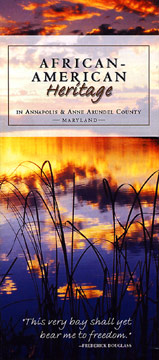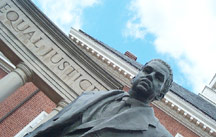|
 To Understand Your History, Get to the Roots To Understand Your History, Get to the Roots
African American Touring in Anne Arundel and Calvert
by Carrie Steele
That flourishing Annapolis gets its nourishment from deep cultural roots is not news. We all know the State Capitol and the Alex Haley statue seated at City Dock. Lesser known are the hundreds of houses, memorials and landmarks woven into city and rural landscapes alike.
As the Haley statue reminds us, modern Chesapeake Country grew from African as well as European roots. Drawing this history to the forefront are the Historic Annapolis Foundation and Kunta Kinte-Alex Haley Foundation, now with the help of the Souza Agency, a multi-cultural marketing firm.
New this year to guide you in an Annapolis roots journey is the Souza Agency’s African-American Heritage, a series of Anne Arundel County self-guided tours with “maps and actual locations that highlight everything anyone that’s looking for historic cultural tourism activities would want,” says the agency’s Roseanne Souza.
The award-winning brochure goes beyond the Kunta Kinte-Alex Haley Memorial and other well-known sights. You’ll learn the African American ties to everyday places such as Quiet Waters Park, St. Anne’s Cemetery and the William Paca House.
Another way to walk in the footsteps of history is with Historic Annapolis Foundation’s African American Heritage audio tour, which can be found in the Annapolis Maritime Museum. You’re first directed toward the City Dock area, where you hear about Alex Haley’s quest to unearth history, represented by his cast-iron statue passing down stories to the child-statues gathered around him. The tour recounts slave ships that docked in the very same Ego Alley waters that lap on the dock beside you. And in the brief overview, you’re reminded that one-third of Annapolis has always been African American.
The Thurgood Marshall statue stands tall in front of the State House, flanked by Equal Justice Under Law pillars and etched marble bearing his accomplishments, as well as two schoolchildren statues that sit on a nearby bench, looking toward Marshall, in dedication to Brown v. Board of Education.
Through the audio tour or the brochure, you’ll find Annapolis brimming with off-the-beaten-path historical sites. See William Butler’s House, home of the former slave who became the first African American to hold public office; learn that the Bank of America on Church Circle stands on what was once the home of the African American founder of Anne Arundel General Hospital; and find that just off State Circle is the Henry Price House, home of Asbury Methodist Church lay minister Dr. Daniel Williams, who performed the first open-heart surgery in 1897.
You’ll find the State House’s memorial plaque of Matthew Henson, who co-discovered the North Pole. While you’re in the State House, see the Civil Rights in Maryland, 1964, black-and-white photo collection.
 |
|
photo by Carrie Steele
|
Add these and others to the more famous St. John’s College, the U.S. Naval Academy, the Banneker-Douglass Museum and the Frederick Douglass Museum & Cultural Center in Highland Beach, and you’ll encounter Annapolis with new eyes.
Don’t just limit your discoveries to Annapolis. There’s plenty to see outside of the city, too, in places throughout Southern
Anne Arundel and Calvert counties.
Long before 1767, when Alex Haley’s roots ancestor, Kunta Kinte, was auctioned from the Lord Ligonier in Annapolis, The Fly had been recorded as the first slaver to sail up the Patuxent River into St. Leonard Creek. So Calvert’s African heritage goes back as far as that 1697 landing. Collecting Calvert County’s African American history in an introductory brochure “is something we’d wanted to do for years,” said the county’s historic preservationist Kirsti Uunila.
For Calvert County’s 350th celebration, Souza and the county’s historic district created another brochure, African-American Voices & Images, which is historic rather than tour directed.
Both brochures are making their way into many hands. African-American Heritage is on its second printing of more than 40,000 brochures, and 20,000 of Calvert’s African-American Voices & Images are now available at libraries.
Once you find the resources to guide your excursions, you can take off on your own history adventure, whether you’re a seasoned history buff or just culturally curious. Through your African American heritage journey, you’ll find new dimensions to abundant history in Annapolis, Anne Arundel and Calvert County.
African-American Heritage brochure at area visitors’ centers and tourism offices, or call the Annapolis & Anne Arundel County Conference & Visitors Bureau: 410-280-0445; www.goannapolis.org. Find Calvert’s brochure in libraries or visitor centers: 800-331-9771; www.co.cal.md.us.
|


 To Understand Your History, Get to the Roots
To Understand Your History, Get to the Roots